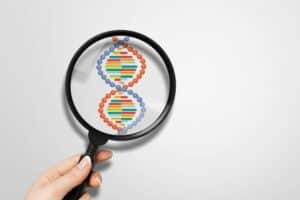Is Autism Genetic? Understanding Its Causes
Autism Spectrum Disorder (ASD) is a complex neurodevelopmental disorder that affects how individuals think, behave, and interact with others. A range of symptoms characterize it, including challenges with social communication, repetitive behaviors, and varying degrees of intellectual disability.
Recent studies suggest that both genetic and environmental factors play significant roles in the development of autism. While the exact causes remain unclear, questions like “Is autism genetic” arise because a combination of genetic risk factors and environmental influences appears to contribute to the onset of ASD.
Success Stories
“Move Up ABA has been a lifeline for our family. Before starting therapy, our son struggled with daily routines and communication. Now, he’s more independent and even initiated a conversation with a classmate for the first time! The progress we’ve seen in just six months is truly remarkable.”
- Emily R., Silver Spring, Accountant
“As a single dad, I was overwhelmed trying to manage my child’s behavior. The Move Up ABA team not only provided amazing support for my little girl but also taught me practical strategies to use at home. Their in-home sessions fit perfectly with our busy schedule. I’m so grateful for their patience and expertise.”
- Michael T., Rockville, Middle School Teacher
“We were hesitant about starting ABA therapy, but Move Up ABA’s approach put us at ease from day one. Our twins have made incredible strides in their social skills and self-regulation. The therapists are like extended family now, and we couldn’t be happier with our decision to work with them.”
- Aisha and James L., Simpson, Police Officers
Genetic and Environmental Factors Influencing Autism

Genetic and environmental factors are considered the two primary contributors to autism spectrum disorders. Understanding how these factors interact is crucial in the exploration of is autism genetic and helps in the ongoing search for effective treatments and interventions.
Genetic factors related to autism include inherited mutations and de novo mutations, which occur spontaneously. These genetic risk factors can affect brain development, leading to the manifestation of autism-related symptoms.
The Role of Genetic Factors in Autism Spectrum Disorder
Genetic factors are a significant part of the autism puzzle, with research showing that certain genes are associated with the condition. Autism genetic studies focus on identifying specific mutations that may increase the risk of developing autism.
Some individuals with autism may have identifiable genetic mutations passed down from their parents, while others may have de novo mutations that appear for the first time in the affected individual, prompting the question: is autism genetic? These genetic variations can affect brain development, contributing to the onset of autism.
How Autism Risk is Linked to Genetics
The genetic risk factors for autism vary among individuals, with some showing clear heritable traits. Family studies have demonstrated that having a sibling with autism increases the likelihood of a diagnosis.
Genetic testing has become a vital tool in autism research, helping to identify specific genetic mutations that may predispose individuals to develop autism. It provides insights into the genetic risk of autism and can assist in early diagnosis and intervention.
Environmental Factors and Their Influence on Autism
In addition to genetic factors, environmental risk factors play a crucial role in the development of autism. These environmental influences can range from prenatal factors, such as maternal health and exposure to toxins, to postnatal influences like childhood vaccinations.
Researchers are examining how certain environmental factors contribute to autism development, including maternal infections during pregnancy or exposure to harmful chemicals. These environmental risk factors can interact with genetic predispositions to increase the likelihood of developing autism.
The Impact of Brain Development on Autism
Autism spectrum disorder is thought to involve atypical brain development, particularly in areas responsible for communication, social behavior, and sensory processing. Neuroimaging studies suggest that certain brain regions in individuals with autism may function differently, contributing to their characteristic symptoms.
Brain development is influenced by a combination of genetic and environmental factors that shape neural networks and pathways. Disruptions during key stages of brain development may contribute to the onset of autism spectrum disorder.
The Importance of Autism Diagnosis in Early Intervention

An early autism diagnosis is crucial for implementing interventions that can improve long-term outcomes for individuals with ASD. Early recognition of symptoms allows for timely support and tailored therapies that address the individual’s specific needs.
Diagnostic tools, such as the Diagnostic and Statistical Manual of Mental Disorders (DSM-5), are used to diagnose autism based on behavioral criteria. Early diagnosis and intervention can significantly improve social, cognitive, and communication skills in affected individuals.
Autism Genetic Testing and Its Role in Diagnosis
Genetic testing plays a pivotal role in diagnosing autism, offering insights into potential genetic causes. It helps identify genetic mutations that may be linked to autism and allows healthcare providers to develop personalized treatment plans.
Genetic testing can uncover underlying genetic risk factors, including de novo mutations, that may contribute to the development of autism. This technology enables a more comprehensive understanding of autism and its genetic basis.
Understanding Intellectual Disability in Autism
Intellectual disability is a common feature of autism spectrum disorder, although not all individuals with ASD experience it. The severity of intellectual disability can vary, ranging from mild to profound, and it can impact the individual’s ability to communicate and function independently.
The relationship between intellectual disability and autism is complex, with genetic factors influencing cognitive abilities. Understanding this connection is important for providing appropriate educational and therapeutic interventions.
Spectrum Disorder and Variations in Autism
Autism spectrum disorders encompass a broad range of presentations, from individuals with high-functioning autism to those with more severe impairments. The spectrum nature of the disorder means that symptoms and severity can differ significantly from person to person.
This variation in autism diagnosis has led to a shift towards a more inclusive understanding of the condition, with an emphasis on individualized care and support. Recognizing these differences helps to tailor interventions that meet the unique needs of each individual.
Autistic Disorder and Its Characteristics

Autistic disorder is one of the specific categories within the autism spectrum and is characterized by significant impairments in social interaction, communication, and behavior. Individuals with autistic disorder may have intellectual disabilities and may require lifelong support.
Although autistic disorder is a severe form of autism, individuals on the spectrum can demonstrate a wide range of abilities and needs. Early interventions, such as behavioral therapy and educational support, can help improve outcomes for individuals with this condition.
The Role of De Novo Mutations in Autism Risk
Genetic changes that arise spontaneously in an individual and are not inherited from either parent refer to de novo mutations. These mutations can increase autism risk by affecting key genes involved in brain development.
Recent research has shown that de novo mutations, including rare mutations, are more common in individuals with autism than in the general population. These mutations may be a significant genetic risk factor for autism and are an area of active investigation in genetic studies.
Environmental Risk Factors for Autism Spectrum Disorder
Environmental risk factors, such as prenatal exposure to toxins, infections, or stress, have been linked to an increased risk of autism. These factors may interact with genetic predispositions to trigger the development of autism spectrum disorder.
Studies suggest that factors such as maternal smoking, advanced paternal age, and prenatal drug exposure can contribute to autism risk. Understanding these environmental factors is essential for preventing or mitigating the impact of autism.
Genetic Risk and Brain Development in Autism
The interplay between genetic risk and brain development is central to understanding autism spectrum disorder. Genetic mutations can disrupt normal brain development, affecting neural circuits that are responsible for social interaction and communication.
Research into how genetic risk factors affect brain development is ongoing, with the goal of identifying specific pathways that contribute to autism. This knowledge may lead to more effective treatments and interventions in the future.
By combining insights from genetic studies, environmental factors, and brain development research, we are better equipped to understand the causes of autism spectrum disorder. Early diagnosis, genetic testing, and targeted interventions remain crucial for improving outcomes for individuals with autism.
The Role of Neurodevelopmental Disorders in Autism
Autism spectrum disorder is categorized as a neurodevelopmental disorder, meaning it involves delays or disruptions in the development of the brain and nervous system. These disorders typically manifest early in life and can affect various aspects of behavior, cognition, and motor skills.
While autism is often diagnosed in early childhood, neurodevelopmental disorders can present differently depending on the severity and the individual’s unique genetic and environmental factors. It’s essential to differentiate autism from other neurodevelopmental disorders to provide the most effective treatments and interventions.
Autism Diagnosis: The Importance of Early Detection

Early autism diagnosis is critical for accessing interventions that can enhance the quality of life for individuals on the spectrum. Timely diagnosis allows for personalized treatment plans that focus on improving communication, social skills, and behavioral outcomes.
Clinicians use tools like the Autism Diagnostic Observation Schedule (ADOS) and the Diagnostic and Statistical Manual of Mental Disorders (DSM-5) to assess individuals for autism. These methods help identify the symptoms of autism at an early stage, ensuring that children receive the appropriate interventions as soon as possible.
Genetic Testing and Personalized Autism Treatment
Genetic testing has become an invaluable tool for understanding the genetic underpinnings of autism spectrum disorders. By identifying specific genetic mutations, healthcare providers can offer more tailored treatments that align with the individual’s unique genetic makeup.
Although genetic testing cannot provide a definitive cure for autism, it helps in understanding genetic risk factors that contribute to the condition. With this information, interventions can be customized to better address the individual’s needs, potentially improving outcomes for those on the spectrum.
Autism and Intellectual Disabilities: The Connection
Intellectual disabilities are common in individuals with autism, though not all people on the spectrum experience cognitive challenges. The presence of intellectual disabilities can complicate social interactions and daily functioning, requiring specialized support and resources.
Individuals with autism and intellectual disabilities may face additional challenges, such as difficulty with speech or adaptive behaviors. However, with early intervention and support, many individuals can achieve significant progress in their social and cognitive skills, improving their overall quality of life.
Understanding Autistic Disorder and Its Variability
Autistic disorder, one of the more severe forms of autism, is characterized by significant deficits in social interactions and communication. The disorder often involves intellectual disabilities, which can affect the individual’s ability to learn and engage in everyday activities.
While some individuals with autistic disorder may require lifelong care, others may develop the skills to live independently. Understanding the full range of symptoms and severity within the spectrum helps tailor treatments to the specific needs of each person with autism.
Genetic Risk Factors: Insights into Autism
Genetic risk factors are central to the development of autism, with several key genes associated with the condition. These genetic risk factors may contribute to differences in brain structure and function, which are thought to underlie autism-related behaviors.
Research into genetic risk factors continues to advance, revealing how inherited mutations and de novo mutations contribute to autism. This growing body of knowledge helps refine our understanding of autism and provides new opportunities for early detection and intervention.
The Influence of Environmental Factors on Autism
In addition to genetic factors, environmental influences also play a significant role in the development of autism. Prenatal exposure to certain toxins or infections may increase the likelihood of developing autism spectrum disorder.
Environmental factors, such as maternal health, nutrition, and exposure to chemicals or medications, can all impact brain development during pregnancy. Identifying these factors is crucial for preventing autism or minimizing its effects on children at risk.
De Novo Mutations: A Key Aspect of Autism Genetics
De novo mutations, which occur spontaneously and are not inherited, are an important area of research in autism genetics. These mutations can affect critical genes involved in brain development, leading to the development of autism spectrum disorder.
Studies have shown that de novo mutations may contribute significantly to autism risk, particularly in cases where no family history of the disorder is present. Understanding these mutations could lead to better early detection methods and targeted treatments for those affected by autism.
Brain Development and Autism Risk
Brain development critically influences the manifestation of autism spectrum disorder. Abnormalities in the development of brain structures responsible for social communication and sensory processing are often observed in individuals with autism.
Genetic and environmental factors can both impact the development of the brain, potentially contributing to the onset of autism. Researchers aim to identify specific brain regions and pathways that may be disrupted in individuals with autism, providing insights into potential therapeutic targets.
Autism Spectrum Disorder and the Genetic-Environmental Interaction
Autism spectrum disorder is influenced by a complex interaction between genetic and environmental factors. Genetic predispositions can make individuals more susceptible to environmental influences, such as prenatal stress or infections, which may increase the risk of developing autism.
This interaction highlights the importance of understanding both genetic risk factors and environmental influences when researching autism. By examining how these factors work together, scientists can develop better prevention and intervention strategies.
Genetic Testing: A Tool for Autism Risk Assessment

Genetic testing is becoming increasingly important in assessing autism risk. By identifying specific genetic variations associated with autism, this testing can help predict an individual’s likelihood of developing the disorder.
Although genetic testing is not yet universally used for diagnosing autism, it provides valuable insights into the genetic underpinnings of the condition. It may also help families understand their genetic risk factors and take preventive measures if necessary.
Conclusion
Understanding autism spectrum disorder requires examining the complex interaction between genetic and environmental factors. Ongoing research into genetic risk factors, environmental influences, and brain development will continue to shape the future of autism diagnosis and treatment.
Early diagnosis and intervention remain crucial in improving outcomes for individuals with autism. By focusing on personalized approaches based on genetic testing and targeted therapies, we can enhance the quality of life for those on the spectrum.
400 E Pratt St, Floor 8 Baltimore , Maryland 21202, United States
Questions?
Email Us: intake@moveupaba.com
Call Us: (410) 469-1090






